Posted by The Listening Suite on 22nd Nov 2021
Hifiology - 2. It's All About Stereo - Part 1
 Early Recording Process
Early Recording Process
Prior to the process of 2 track tape recording and multi track tape recording, using 2, 3, 4, 8, 16, and 24 Track tape machines, sound recording artists had to perform and record all at the same time.
A Brief History Lesson:

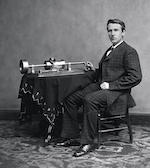
1878 - Thomas Edison’s invents the Tin Foil Phonograph and records the very first sound recording, a rendition of “Mary Had a Little Lamb.” recorded June 22nd 1878.
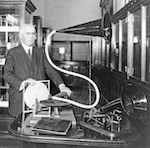
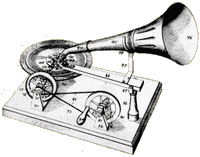
1894 - Emile Berliner invents the Gramophone and the Gramophone record.
1898 - 78 rpm discs are introduced
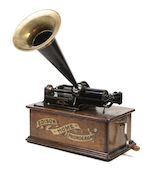
1899 - Thomas Edison introduces the Wax Cylinder Phonograph
1901 - 10” 78 rpm Shellac records are introduced.
1903 - 12” 78 rpm Shellac records are introduced.
1910 - World's first Public Radio broadcast is made in New York City on January 13, 1910.
1914 - 1918 World War I
1925 - Microphones replace the use of horns, greatly improving the process of recording sound.
Early recordings used horns to capture sound which was recorded onto lacquer discs via a stylus cutter, but the process was still limited to the use of lacquer discs via a stylus cutter.
The lacquer discs had a limited use as they could only be used once, any mistakes during the recording and the recording process begins all over again.
1925 - Irish radio station 2RN begins broadcasting test transmissions, heralding the beginning of radio broadcasting in Ireland.
1929 - Thomas Edison ceases production of wax cylinders as 78 rpm gramophone discs gain in popularity.
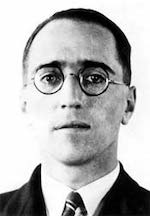
1933 - Alan Blumlein invents Stereo
1939 - 1945 World War 2
1943 - 2 Track 1/4 inch Tape Machines & 2 Track Tape Recording Process
High quality 2 Track Stereo tape recording began in Germany 1943, and following the end of World War II, the US based Ampex corporation developed the commercial use of 2 Track Stereo tape recording in the USA.
The company's first tape recorder, the Ampex Model 200, was first shipped in April 1948. During the 1950s 2-track tape recording became the norm for either mono or stereo recordings.
Binaural Stereo recordings using 2 microphones or recordings using multiple microphones mixed together for 2 channel using a mixing console where mainly used to record classical music in Stereo, whereas popular and jazz recordings where recorded in mono until the late 1960s. With the introduction of tape machines the use of lacquer discs and a stylus cutter ceased, but still sound recording artists had to perform and record all at the same time, due to the fact that tape machines only had 2 channels and these channels could not be individually placed into record, very similar to a cassette tape recorder.
Recordings could only be recorded in mono and later in 2 channel stereo.
This recording method relied on recording multiple takes of the same live performance, take 1, take 2 etc.
Once all takes had been recorded, each take was then played back and judged for its overall performance in relation to all the other takes that had been recorded. Sometimes the 1st take became the master take or the master take was compiled via editing or splicing together various sections taken from the other recorded takes.

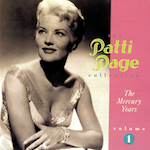
1947 - First Vocal Overdub - Pattie Page and the song ‘Confess’.
The artist Pattie Page was the first singer to overdub or multitrack her vocals on a song called, ‘Confess’. The song was recorded and engineered by Bill Putnam at Mercury Records and features the swing jazz guitarist George Warren Barnes who played the first electric guitar in 1931, he is said to have made the first commercial recording of an electric guitar on March 1, 1938.
Note: As this recording is in Mono and played back using two speakers, when the listener is positioned centrally between the Left and Right speakers, the recorded performance appears to be placed centrally between the Left & Right speakers.
Multitrack Recording & Les Paul
The first recording artists to use a custom-built eight-track recorder from Ampex nicknamed the “Octopus" was the guitarist, composer and technician Les Paul and his singing wife, Iris Colleen Summers who’s stage name was Mary Ford. The name “Octopus" was inspired by comedian W.C. Fields who after listening to Les Pauls recordings said “My boy, you sound like an octopus”. Multitrack recording enabled recording engineers to record each musical instrument and vocals separately. Engineers could now adjust the level and tone of each recorded instrument or vocal. Reverb and other effects could now be applied to individual tracks. Lead vocals could be recorded separately and harmony vocals overdubbed later.
1950s - 3 Track 1/2 inch Tape Machines
Also introduced in the early 1950s where 3 track tape machines.
These machines enabled the sound engineer to record the backing tracks onto two tracks either as separate backing tracks 1 and 2 or a Stereo Left and Right mix with the additional third track being used to record the lead instrument or lead vocal. Three-track recorders remained in widespread commercial use until the mid-1960s.
1950 - 33⅓ rpm LP (Long Play) records featuring ‘micro’ grooves are introduced
1951 - 45 rpm records are introduced
1952 - Dansette Portable Record Players introduced, Production period 1952 - 1969
1954 - Elvis Presley records “That’s All Right”, July 1954 at Sun Studios using a Mono 1/4” Ampex 350 Tape machine. The song was written and originally recorded by Arthur “Big Boy” Crudup in Chicago on September 6, 1946.

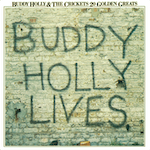
1958 - Buddy Holly ‘True Love Ways’ from the Album, Buddy Holly Lives
Buddy Holly along with the Dick Jacobs Orchestra recorded the song ‘True Love Ways’ at the Pythian Temple in New York City on October 21st, 1958. In the first ten seconds of the extended version of the song featured on the album, ‘Buddy Holly Lives’ the following can be heard:
"Yeah, we're rolling." (Centre)
The piano player plays a B-flat note, (Right Channel) Buddy Holly says “Okay" (Centre) followed by tinkering on the Guitar (Right Channel) and Harp (Left Channel)
The producer shouts, "Quiet, boys" (Left Channel)
Buddy Holly clears his throat. (Centre)
The producer says "Pitch, Ernie", (Left Channel) to signal the piano player to give Holly his starting note, a B-flat. (Right Channel)
Drums, Clifford Leman (Right Channel)
Bass, Sanford Bloch (Right Channel)
Guitar, Al Caiola (Right Channel)
Piano, Ernest Hayes (Right Channel)
Vocal, Buddy Holly (Centre)
Saxaphone, Abraham Richman (Left Channel) 0.37 0.53
Conductor, Dick Jacobs
Strings,
8 Violins, (Left Channel)
2 Violas, (Left Channel)
2 Cellos, (Left Channel)
1 Harp, Doris Johnson (Left Channel) 0.59
Note:
The same recording features on the album ‘The Rough Guide to Buddy Holly and The Crickets’
but the Left and Right channels are reversed. (Note to Mastering Engineer)

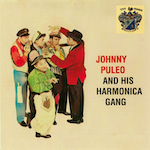
1958 - First 12” Stereo Vinyl Record - Johnny Puleo and his Harmonica Gang
The first mass-produced commercially available 12” Stereophonic long-playing record was released in March 1958
by the artist, Johnny Puleo and his Harmonica Gang on the New York based, Audio Fidelity Record Label (AFSD 5830).
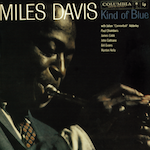
1959 - Miles Davis - Kind of Blue - Released August 15, 1959
Kind of Blue was recorded on a three-track tape machine and released in both Mono & Stereo
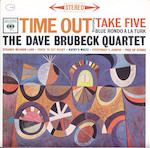
1959 - The Dave Brubeck Quartet - Time Out - Released December 14th, 1959

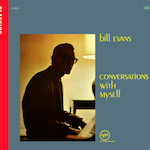
1963 - The album ‘Conversation with Myself’, by Bill Evans.
Example of early overdubbing or multitracking technique using a 3 Track 1/2 inch Tape Machine.
This recording demonstrates the early adaptation of the overdubbing or multitracking technique.
The listener can hear 3 piano performances positioned as follows,
Left Speaker - Phantom Centre (Sound appears centrally between the L&R Speakers) and the Right Speaker.

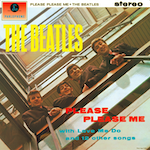
1963 - ‘Please Please Me’ by the Beatles from the album titled ‘Please Please Me’
This recording features the Drums, Bass Guitar and Lead Guitar panned to the Left Speaker
and the Lead Vocals and Harmony Vocals panned to the Right speaker.
1965 - 4 Track / 1 inch Tape Machines

In 1965, Abbey Road Recording Studios purchased four Studer J37 - 4 track / 1 inch tape machines,
prior to the Studer J37, Abbey Road used Telefunken 4 track tape machines.
The Studer J37s were used on almost every recording until 8-track machines were introduced to Abbey Road Studios in 1969.
The Beatles @ Abbey Road Studios
All of the Beatles mid-1960s recordings, including the most famous album ‘Sgt Pepper’s Lonely Hearts Club Band’
where recorded using Studer J37 4 track / 1 inch tape machines.
1950 - 1970 - The Listener At Home
Prior to the 1950s the general public had mainly been listening to recordings in Mono using one speaker.
Following the introduction of the 33 1/3 Stereo LP record in 1956, two speakers where now required.
Popular at the time plus an item of household furniture where large wooden cabinets called Radiograms or Stereograms which combined a radio and gramophone / vinyl record player. These units featured valve electronics plus an internally housed large Mono speaker or pair of speakers for stereo reproduction. With the introduction of the transistor these units started to be slowly replaced with separate hifi components and separate left and right speakers. As the speakers in the Stereogram where positioned at a fixed distance apart within the Stereogram, the stereo soundstage was greatly reduced with very little separation of the left and right channels. I believe this is why certain recordings at the time such as the Beatles ‘Please Please Me’ was mixed featuring the Drums, Bass Guitar and Lead Guitar coming from the Left Speaker and the Lead Vocals and Harmony Vocals coming from the Right speaker. Remember it’s 1963 and Stereo playback is still in its infancy, so hearing the drums on the left and the vocals on the right would have been very new and exciting for the listener at the time. With the introduction of separate Left and Right speakers in the late 1960s early 70s, Hifi enthusiasts began to experiment with the positioning of their speakers in their homes. Terms like Soundstage, Depth, Width, Height, Toeing in,Toeing out and the infamous positioning triangle are born.
Stereo would never be the same again.
Note: All Images remain the copyright property of their respective owners
